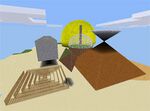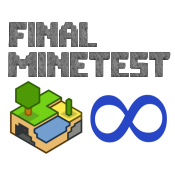Mods/WorldEdit
| WorldEdit | |
|---|---|
| A mod | |
| Mod Type | Maintenance |
| Author | Various contributors |
| Forum topic | 572 |
| Source code | GitHub |
| ContentDB | N/A |
| Technical name | worldedit |
WorldEdit is a Minetest modpack created by various authors. It is an in-game world editor. Use it to repair griefing, or just create awesome buildings in seconds.
Download
You can download WorldEdit either from GitHub or ContentDB.
Usage
Please see the WorldEdit Tutorial.
WorldEdit API
This API is documented in the WorldEdit API Reference.
Axes
The coordinate system is the same as that used by Minetest; positive Y is upwards, positive X is rightwards, and positive Z is forwards, if a player is facing North (positive Z axis).
When an axis is specified in a WorldEdit chat command, it is specified as one of the following values: x, y, z, or ?.
In the GUI, there is a dropdown menu for this purpose. The "Look direction" option has the same effect as ? does in chat commands.
The value ? represents the axis the player is currently facing. If the player is facing more than one axis, the axis the player face direction is closest to will be used.
Nodes
Node names are required for many types of commands that identify or modify specific types of nodes. They can be specified in a number of ways.
First, by description - the tooltip that appears when hovering over the item in an inventory. This is case insensitive and includes values such as "Cobblestone" and "bronze block". Note that certain commands (namely, //replace and //replaceinverse) do not support descriptions that contain spaces in the <searchnode> field.
Second, by name - the node name that is defined by code, but without the mod name prefix. This is case sensitive and includes values such as "piston_normal_off" and "cactus". Nodes defined in the default mod always take precedence over other nodes when searching for the correct one, and if there are multiple possible nodes (such as "a:celery" and "b:celery"), one is chosen in no particular order.
Finally, by full name - the unambiguous identifier of the node, prefixes and all. This is case sensitive and includes values such as "default:stone" and "mesecons:wire_00000000_off".
The node name "air" can be used anywhere a normal node name can, and acts as a blank node. This is useful for clearing or removing nodes. For example, //set air would remove all the nodes in the current WorldEdit region. Similarly, //sphere 10 air, when WorldEdit position 1 underground, would dig a large sphere out of the ground.
Regions
Most WorldEdit commands operate on regions. Regions are a set of two positions that define a 3D cuboid. They are local to each player and chat commands affect only the region for the player giving the commands.
Each positions together define two opposing corners of the cube. With two opposing corners it is possible to determine both the location and dimensions of the region.
Regions are not saved between server restarts. They start off as empty regions, and cannot be used with most WorldEdit commands until they are set to valid values.
Markers
Entities are used to mark the location of the WorldEdit regions. They appear as boxes containing the number 1 or 2, and represent position 1 and 2 of the WorldEdit region, respectively.
To remove the entities, simply punch them. This does not reset the positions themselves.
Schematics
WorldEdit supports two different types of schematics.
The first is the WorldEdit Schematic format, with the file extension ".we", and in some older versions, ".wem". There have been several previous versions of the WorldEdit Schematic format, but WorldEdit is capable of loading any past versions, and will always support them - there is no need to worry about schematics becoming obselete.
As of version 5, WorldEdit schematics include a header. The header is seperated from the content by a colon (:). It contains fields seperated by commas (,). Currently only one field is used, which contains the version in ASCII decimal.
The current version of the WorldEdit Schematic format is essentially an array of node data tables in Lua 5.1 table syntax preceded by a header. Specifically it looks like this:
5:return {
{
y = <y-axis coordinate>,
x = <x-axis coordinate>,
z = <z-axis coordinate>,
name = <node name>,
param1 = <param1 value>,
param2 = <param2 value>,
meta = <metadata table>,
},
<...>
}
The ordering of the values and minor aspects of the syntax, such as trailing commas or newlines, are not guaranteed to stay the same in future versions.
The WorldEdit Schematic format is accessed via the WorldEdit API, or WorldEdit serialization chat commands such as //serialize and //deserialize.
The second is the Minetest Schematic format (MTS). The details of this format may be found in the Minetest documentation and are out of the scope of this document. Access to this format is done via specialized MTS commands such as //mtschemcreate and //mtschemplace.


